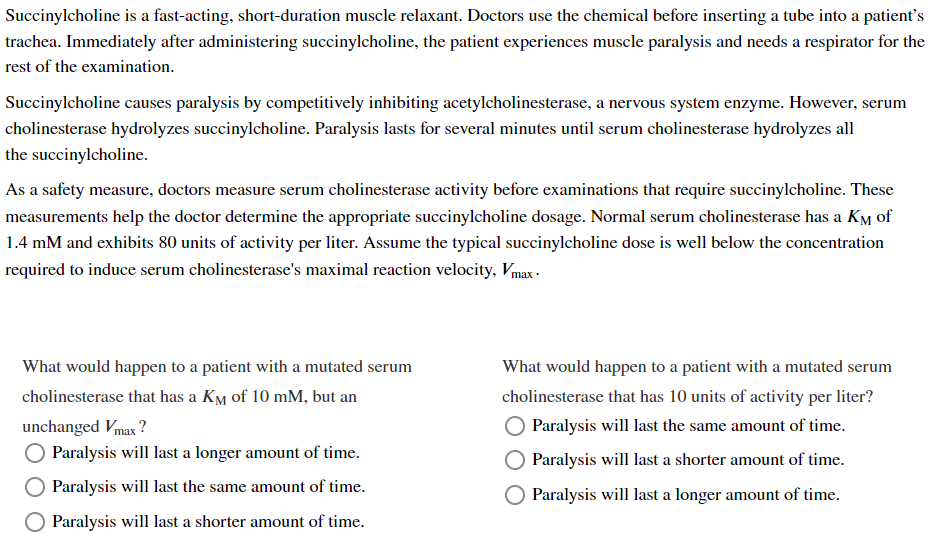Succinylcholine is a fast-acting, short-duration muscle relaxant. Doctors use the chemical before inserting a tube into a patient's trachea. Immediately after administering succinylcholine, the patient experiences muscle paralysis and needs a respirator for the rest of the examination. Succinylcholine causes paralysis by competitively inhibiting acetylcholinesterase, a nervous system enzyme. However, serum cholinesterase hydrolyzes succinylcholine. Paralysis lasts for several minutes until serum cholinesterase hydrolyzes all the succinylcholine. As a safety measure, doctors measure serum cholinesterase activity before examinations that require succinylcholine. These measurements help the doctor determine the appropriate succinylcholine dosage. Normal serum cholinesterase has a KM of 1.4 mM and exhibits 80 units of activity per liter. Assume the typical succinylcholine dose is well below the concentration required to induce serum cholinesterase's maximal reaction velocity, Vmax. What would happen to a patient with a mutated serum cholinesterase that has a KM of 10 mM, but an unchanged Vmax ? Paralysis will last a longer amount of time. Paralysis will last the same amount of time. Paralysis will last a shorter amount of time. What would happen to a patient with a mutated serum cholinesterase that has 10 units of activity per liter? Paralysis will last the same amount of time. Paralysis will last a shorter amount of time. Paralysis will last a longer amount of time.
Succinylcholine is a fast-acting, short-duration muscle relaxant. Doctors use the chemical before inserting a tube into a patient's trachea. Immediately after administering succinylcholine, the patient experiences muscle paralysis and needs a respirator for the rest of the examination. Succinylcholine causes paralysis by competitively inhibiting acetylcholinesterase, a nervous system enzyme. However, serum cholinesterase hydrolyzes succinylcholine. Paralysis lasts for several minutes until serum cholinesterase hydrolyzes all the succinylcholine. As a safety measure, doctors measure serum cholinesterase activity before examinations that require succinylcholine. These measurements help the doctor determine the appropriate succinylcholine dosage. Normal serum cholinesterase has a KM of 1.4 mM and exhibits 80 units of activity per liter. Assume the typical succinylcholine dose is well below the concentration required to induce serum cholinesterase's maximal reaction velocity, Vmax. What would happen to a patient with a mutated serum cholinesterase that has a KM of 10 mM, but an unchanged Vmax ? Paralysis will last a longer amount of time. Paralysis will last the same amount of time. Paralysis will last a shorter amount of time. What would happen to a patient with a mutated serum cholinesterase that has 10 units of activity per liter? Paralysis will last the same amount of time. Paralysis will last a shorter amount of time. Paralysis will last a longer amount of time.
Essentials of Pharmacology for Health Professions
7th Edition
ISBN:9781305441620
Author:WOODROW
Publisher:WOODROW
ChapterCRE2: Comprehensive Review Exam For Part 2
Section: Chapter Questions
Problem 15CEP2
Related questions
Question
100%
Q10:

Transcribed Image Text:Succinylcholine is a fast-acting, short-duration muscle relaxant. Doctors use the chemical before inserting a tube into a patient's
trachea. Immediately after administering succinylcholine, the patient experiences muscle paralysis and needs a respirator for the
rest of the examination.
Succinylcholine causes paralysis by competitively inhibiting acetylcholinesterase, a nervous system enzyme. However, serum
cholinesterase hydrolyzes succinylcholine. Paralysis lasts for several minutes until serum cholinesterase hydrolyzes all
the succinylcholine.
As a safety measure, doctors measure serum cholinesterase activity before examinations that require succinylcholine. These
measurements help the doctor determine the appropriate succinylcholine dosage. Normal serum cholinesterase has a Kỵ of
1.4 mM and exhibits 80 units of activity per liter. Assume the typical succinylcholine dose is well below the concentration
required to induce serum cholinesterase's maximal reaction velocity, Vmax.
What would happen to a patient with a mutated serum
cholinesterase that has a Kỵ of 10 mM, but an
unchanged Vmax ?
Paralysis will last a longer amount of time.
Paralysis will last the same amount of time.
Paralysis will last a shorter amount of time.
What would happen to a patient with a mutated serum
cholinesterase that has 10 units of activity per liter?
Paralysis will last the same amount of time.
Paralysis will last a shorter amount of time.
Paralysis will last a longer amount of time.
Expert Solution
This question has been solved!
Explore an expertly crafted, step-by-step solution for a thorough understanding of key concepts.
This is a popular solution!
Trending now
This is a popular solution!
Step by step
Solved in 4 steps

Recommended textbooks for you

Essentials of Pharmacology for Health Professions
Nursing
ISBN:
9781305441620
Author:
WOODROW
Publisher:
Cengage


Human Physiology: From Cells to Systems (MindTap …
Biology
ISBN:
9781285866932
Author:
Lauralee Sherwood
Publisher:
Cengage Learning

Essentials of Pharmacology for Health Professions
Nursing
ISBN:
9781305441620
Author:
WOODROW
Publisher:
Cengage


Human Physiology: From Cells to Systems (MindTap …
Biology
ISBN:
9781285866932
Author:
Lauralee Sherwood
Publisher:
Cengage Learning